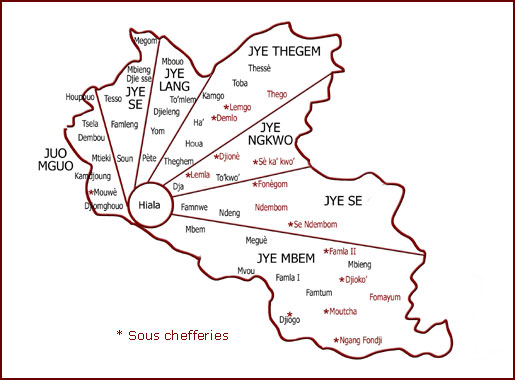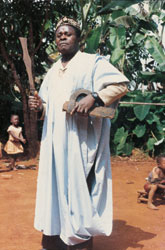
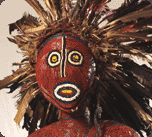 |
|
| The Bandjoun museum | |
| Permanent exhibition | |
| Information | |
Kingdom and society
Territorial organisation
A sort of capital, the le tsa is where the king, his family and collaborators reside. The main administrative, religious and cultural centre of the kingdom, it includes: the market; the royal sanctuary; the residence of the fo and the external dependences. It is located in the royal quarter (called hyala). In the past, the territorial space of Bandjoun familiarly included two sectors: the capital or the domain of the fo and the surroundings; then the "province" with the sub-chefferies and the quarters outside the first circle. This latter sector was called "mpfop" and the first, for the sake of simplification, hyala. |
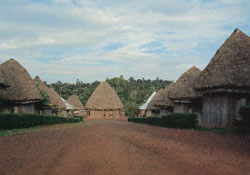 |
|
| |
|
The sub-chefferie, or dependent ‘to’, can either be an ancient defeated and vanquished chefferie or a chefferie that voluntarily put itself under the protection of a fo during troubles that threatened it, or even a territory given to a fugitive chief who accepted becoming a vassal of the fo. It benefits from an internal autonomy and its organisation (outside the provinces) is a replica, on a smaller scale, of that of the kingdom. In particular, it has its own customary societies, its notables, its art objects and sometimes its own language (Moutcha, Djiko, Fomeyum for example). It is governed by the foto, a dependent or vanquished chief who keeps certain administrative prerogatives. Bandjoun has about twenty sous-chefferies of which the one with the highest number of inhabitants is Famla II (formerly Moudjo) with a population of more than 10,000. |
|
| |
Kings and co-founders
| The fo, a deified figure, grand master of the gung and representing the ancestor founders of Bandjoun, is at the summit of the hierarchical society. He holds supernatural powers. The sacred authority is transmitted from father to son according to a complex ritual of initiation and enthronement. He has undergone several ritual and magic rituals which have made him a sacred figure and master of kè (power of life, the occult forces and magic). |
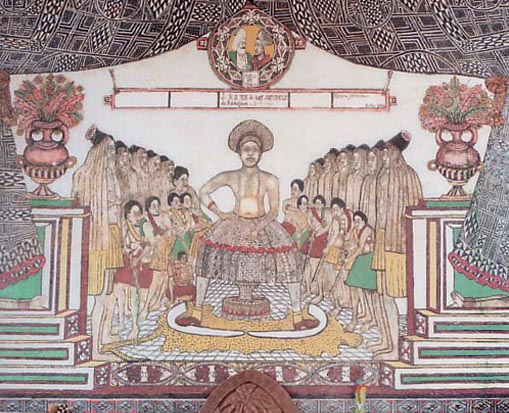 |
The fo has very extensive powers and attributions. He is the arbiter of all the balances of the group; the master of natural elements, priest, religious chief; war chief, responsible for traditional justice, overseer of the territory and the living symbol of the fertility and prosperity of his people and kingdom, etc. |
However, the powers of the fo are counter-balanced by the notables mkam (singular kam) grouped into secret societies mkem and councils. The most important council that that of the nine “mkamvu’u”, co-founders of the kingdom, a genuine political and religious body of the theocratic government of Bandjoun. It is at one and the same time a religious and political society which initiates and enthrones the fo, mystically protects the country and represents the people. It initially included the descendants of the nine founders of the kingdom and the function is hereditary. The council expanded to include other dignitaries wambo, wafo, kwipu or mafo, who were also descendants of the previous reigns. The mkamvu’u has more than thirty members. The nine notables (Tekomghè is their head) who alone are entitled to take part in the resolutions and decisions must be distinguished. |
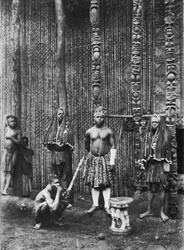 |
|
| |
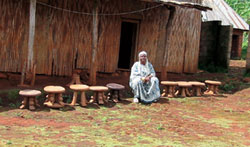 |
The attributions, the power, the functions and the prestige of the fo (king) and the co-founders of the kingdom are materialised by various symbols, objects of cult and cultural artefacts. Art here is a visualisation of power and the various aspects of social life. A certain number of animals (panthers, elephants, snakes, etc.) are the symbols of royal power. |
|
| |
|
|
|
|
Dignitaires et serviteurs
Le fo (roi) occupe une place exceptionnelle dans la société Bandjoun fortement hiérarchisée et qui comprend en général trois strates non figés: les descendants du fo et les co-fondateurs mkamvu’u (jusqu'à la 2 ème génération); les serviteurs, les héritiers des serviteurs du fo et autres gens anoblis; les simples habitants sans titre. On peut diviser la société en deux grandes catégories: d'un côté les notables mkam associés au fo avec une subdivision en notables royaux et en notables roturiers; les simples habitants sans titres, mais de rang inférieur. |
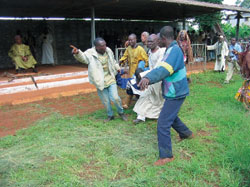 |
|
La division de la société en plusieurs groupes hiérarchisés selon les grades reste l'un des facteurs d'une lutte permanente pour les titres, auxquels sont attachés avantages et honneurs. La stratification sociale dynamique se traduit clairement dans le port des coiffures et des parures, la possession de certains objets (récipients, maisons, mobilier, instruments de musique, etc.).
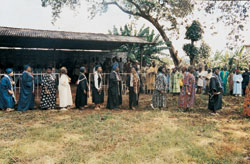 |
Le fo est entouré des dignitaires et serviteurs occupant de multiples fonctions et une place précise dans la hiérarchie sociale: la mafo (la mère réelle du chef ou sa sœur intronisée); les serviteurs (tshofo), futurs prêtres chargés des cultes royaux ou cadres de l'administration du royaume, les uns (tshofoshe) au palais du fo (et commandé par le tadié), les autres (kamguè, mgueh) au fam (commandés par les ngwala); les wambo qui ont fait preuve d'un dévouement remarquable à l'égard du royaume et du fo; l'état major personnel d'un nouveau fo ou de chaque règne (le kwipu, le wafo, le suop, le defo et le tabue dont les fonctions sont héréditaires). | |
| |
La notablité ici s'exprime non seulement par les titres, mais aussi par des insignes qui en précisent le degré, par les types d'objets que détient les titulaires.
|
|
[ Top page ]
| Home | The four museums | The project | Baham museum | Bandjoun museum | Mankon museum | Babungo museum |
| bandjoun@museumcam.org | Copyright 2005 C.O.E. | Powered by SYNUS |
